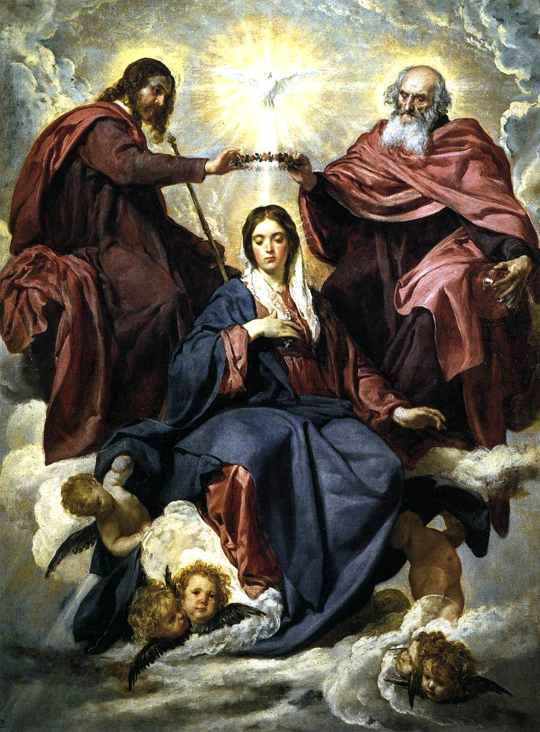When we pray the Magnificat of Mary, we sing to the Lord with her in the opening line: My soul proclaims the greatness of the Lord, my spirit rejoices in God my Savior. Mary rejoices because she needs the Saviour! She sees the greatness of the Lord’s salvation at work in her holy life.
Thanks to her undisputed and sublime humility, Mary mirrors to us the road to holiness, paved by small steps of the finest and highest forms of humility. She confesses it herself in the next lines of the Magnificat: for he has looked with favour on his lowly servant. From this day all generations will call me blessed: the Almighty has done great things for me, and holy is his Name.
It is right and just to extol the greatness of Our God since He has wrought great things in and through Mary! Thus, what we say about Mary is directly referable to God Himself, the author of every good work. Through God’s grace, Mary was equipped before her immaculate conception for every good work (2 Tim 3:17). She was ready for any good work (Tim 2:21) because she let He who began a good work in [her] will bring it to completion at the day of Jesus Christ (Phil 1:6). Mary’s life is an ongoing canticle of praise to God the Almighty because she lead a life worthy of the Lord, fully pleasing to him, bearing fruit in every good work and increasing in the knowledge of God (Col 1:10).
Generations has spoken about God’s marvellous deeds through Mary! Pope St John Paul II highlights the privilege of Mary’s Assumption into heaven as pure fruit of divine grace.
Today the liturgy invites us to contemplate Mary, taken up body and soul into heaven. By a special privilege, she was enriched by divine grace from the moment of her conception, and Christ, who ascended to the right hand of the Father, opened the doors of his kingdom to her, first among human creatures. Now from heaven, where the Queen of the angels and saints is crowned, the Mother of God and of the Church is close to the Christian people before whom she shines as the “new and immaculate woman (who) mediated for the guilt of the first woman.”
Even Carl Jung extols God’s wonder in Mary when she was established as Queen of heaven and Bride at the heavenly court by the Holy Trinity.
One could have known for a long time that there was a deep longing in the masses for an intercessor and mediatrix who would at last take her place alongside the Holy Trinity and be received as the ‘Queen of heaven and Bride at the heavenly court.’ For more than a thousand years it has been taken for granted that the Mother of God dwelt there. I consider it to be the most important religious event since the Reformation.
St Louis Marie De Montfort encourages us that when we honour Mary we are honouring her Son Jesus because Him we honour in honouring her. She leads us to Him.
We never give more honour to Jesus than when we honour his Mother, and we honour her simply and solely to honour him all the more perfectly. We go to her only as a way leading to the goal we seek – Jesus, her Son.”
Mary is our perfect teacher in the sublimest virtue of charity, namely that of satiating God’s thirsting in the poor.
How much we need Mary to teach us what it means to satiate God’s Thirsting Love for us, which Jesus came to reveal to us. She did it so beautifully. Yes, Mary allowed God to take possession of her life by her purity, her humility, and her faithful love…Let us seek to grow, under the guidance of our Heavenly Mother…
Mary’s Assumption into heaven is an excellent proof of God’s total love for Mary. Fr Albert W. Cylwicki, CSB writes:
Today’s feast of her assumption into heaven is proof of this. By raising her from the dead and taking her into heaven – body and soul – God demonstrated his undying love for Mary. Like Shah Jahan, God could not bear the death of his beloved. However, God could do what no Indian emperor could do – raise his beloved from the dead and restore her to life even more beautiful than before. Moreover, God didn’t have to build a Taj Mahal to memorialize Mary. Her glorified body is itself a magnificent temple of the Holy Spirit.’
God’s brilliant work in Mary is made visible to us because He works in and through her to protect us from evil. Let us be encouraged by the undying words of St Bernard of Clairvaux:
‘In dangers, in doubts, in difficulties, think of Mary, call upon Mary. Let not her name depart from your lips, never suffer it to leave your heart. And that you may obtain the assistance of her prayer, neglect not to walk in her footsteps. With her for guide, you shall never go astray; while invoking her, you shall never lose heart; so long as she is in your mind, you are safe from deception; while she holds your hand, you cannot fall; under her protection you have nothing to fear; if she walks before you, you shall not grow weary; if she shows you favour, you shall reach the goal.’
Now I can truly understand why the Byzantine liturgy rightly salutes Mary with the following words in the feast of the Dormition of the Most Holy Theotokos:
All generations bless thee, O thou only Theotokos. In thee, O spotless Virgin, the laws of nature were suspended; for thy virginity was preserved in thy child-bearing, and Life is joined with death. Thou, O Theotokos, didst remain a Virgin after child-birth, and after death art still alive and dost ever deliver Thine heritage.
In the collect for the solemnity of the Assumption of Mary the Western Church prays:
Father in heaven, all creation rightly gives you praise, for all life and all holiness come from you. In the plan of your wisdom she who bore the Christ in her womb was raised body and soul in glory to be with him in heaven. May we follow her example in reflecting your holiness and join in her hymn of endless love and praise. We ask this through Christ our Lord. Amen.
Is Mary’s Assumption into heaven not a very eloquent sign of God’s eternal holiness in and through her?












